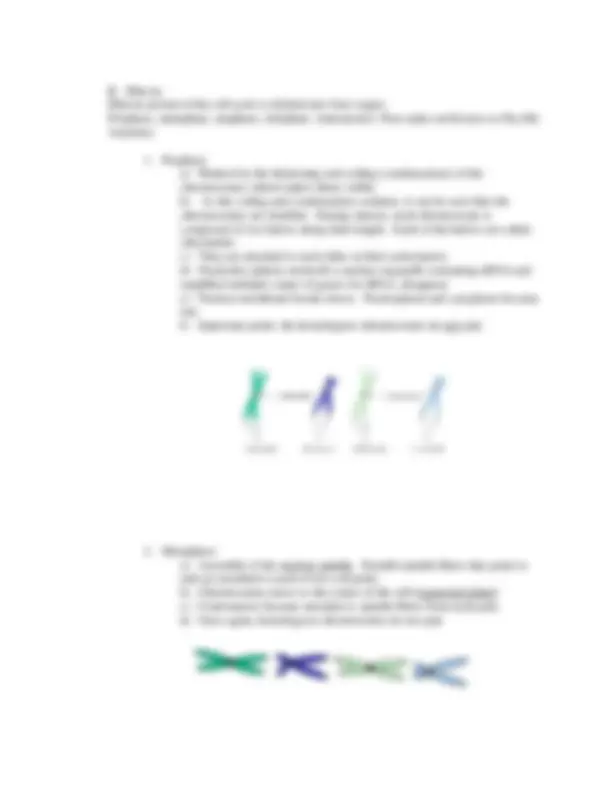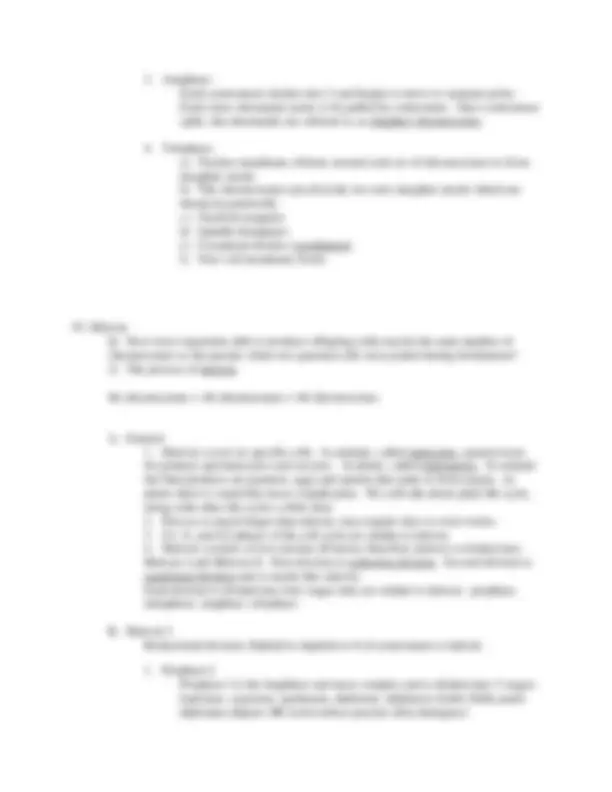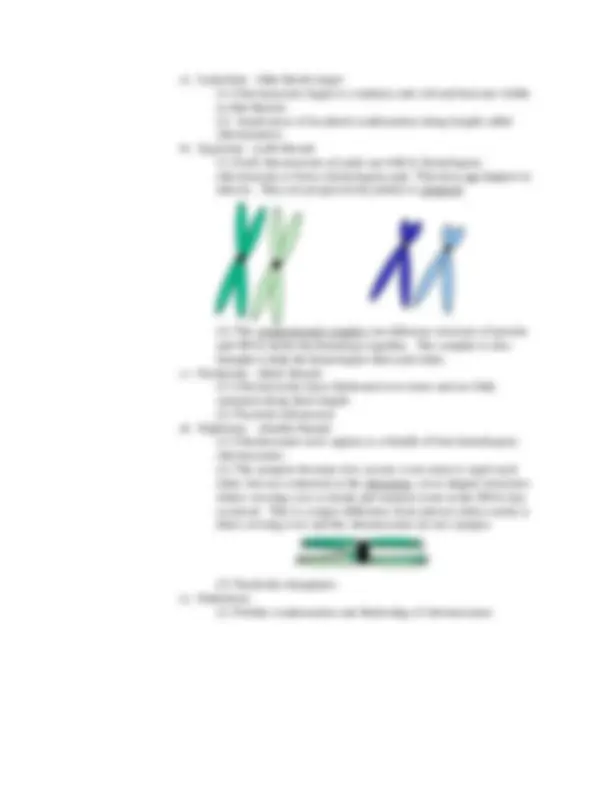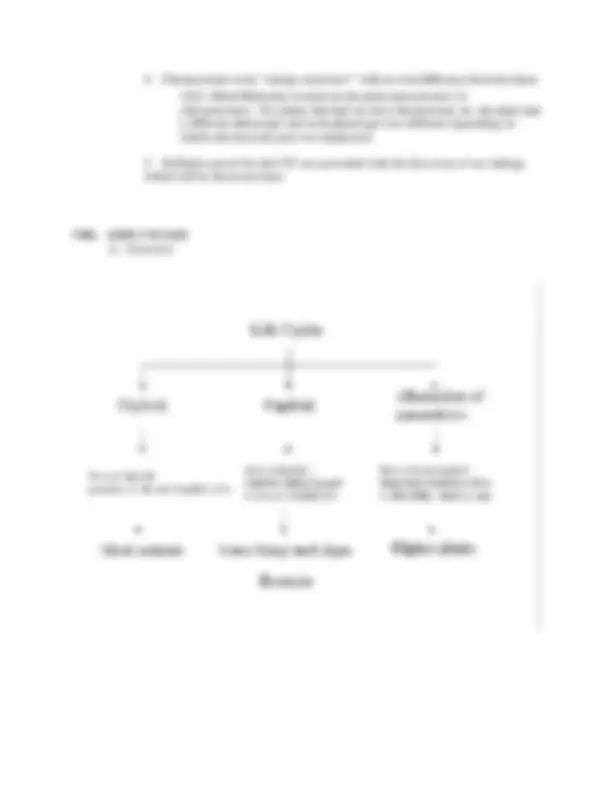








Study with the several resources on Docsity

Earn points by helping other students or get them with a premium plan


Prepare for your exams
Study with the several resources on Docsity

Earn points to download
Earn points by helping other students or get them with a premium plan
Community
Ask the community for help and clear up your study doubts
Discover the best universities in your country according to Docsity users
Free resources
Download our free guides on studying techniques, anxiety management strategies, and thesis advice from Docsity tutors
The chromosomal theory of inheritance in briefly explanation about mitosis and life cycle.
Typology: Lecture notes
1 / 12

This page cannot be seen from the preview
Don't miss anything!







Chapter 3: The Chromosomal Theory of Inheritance
I. A prelude to the chromosomal theory of inheritance (genes/Mendel’s factors are part of cellular structures called chromosomes) A. Discoveries leading up to the CTI
B. Let’s look at the process and behavior of chromosomes during mitosis and meiosis to see how they qualify for the designation of hereditary material. These are the observations that led to the CTI.
A. Chromosome sets. Higher organisms contain two similar sets of chromosomes in somatic cells. One set came from the male parent and the other set came from the female parent. Each member of a set has a homologous partner, and two members of a pair are called homologues (meaning same shape). In humans: 23 pairs of chromosomes = 46 chromosomes total In Drosophila: 4 pairs of chromosomes = 8 chromosomes total
B. Haploid: a cell or organism having only one set of chromosomes
C. Diploid: a cell or organism having two complete sets of homologous chromosomes (referred to as 2n where n = the number of chromosomes in a set)
Mendel's peas: 2n = 2(7 chromosomes in one set) = 14 Humans: 2n = 2(23 chromosomes in one set) = 46 Drosophila: 2n = 2(4 chromosomes in one set) = 8
D. Genome: the total complement of genes contained in a cell.
Nuclear division accompanied by a cell division that produces 2 daughter cells having genetic material identical to the parent A. General info
IV. Meiosis Q: How were organisms able to produce offspring with exactly the same number of chromosomes as the parents when two parental cells were joined during fertilization? A: The process of meiosis.
46 chromosomes + 46 chromosomes = 46 chromosomes
A. General
B. Meiosis I Reductional division: Diploid to haploid or # of centromeres is halved.
a) Leptotene: (thin thread stage) (1) Chromosomes begin to condense and coil and become visible as thin threads. (2) Small areas of localized condensation along length called chromomeres. b) Zygotene: (yolk thread) (1) Each chromosome set pairs up with its homologous chromosome to form a homologous pair. This does not happen in mitosis. They are progressively joined or synapsed.
(2) The synaptonemal complex (an elaborate structure of protein and DNA) holds the homologs together. The complex is also thought to help the homologues find each other. c) Pachytene: (thick thread) (1) Chromosomes have thickened even more and are fully synapsed along their length. (2) Nucleoli still present d) Diplotene: (double thread) (1) Chromosomes now appear as a bundle of four homologous chromosomes. (2) The synapsis becomes less secure, even seem to repel each other, but are connected at the chiasmata, cross-shaped structures where crossing over (a break and reunion event in the DNA) has occurred. This is a major difference from mitosis where rarely is there crossing over and the chromosomes do not synapse.
(3) Nucleolus disappears e) Diakinesis: (1) Further condensation and thickening of chromosomes.
V. Summary:
(from An Introduction to Genetic Analysis, 6th ed. By Griffiths et al. W. H. Freeman and Company)
VI. The chromosomal theory of inheritance
1902 - With evidence presented by other researchers of the behavior of chromosomes, Walter Sutton (an American graduate student) and Theodor Boveri (German biologist) recognized independently that the factors described in Mendel's paper could be explained by consideration of the behavior of chromosomes during meiosis. Known as the Sutton- Boveri chromosome theory of heredity.
(from An Introduction to Genetic Analysis, 6th ed. By Griffiths et al. W. H. Freeman and Company)
VII. Objections and counter objections to the chromosome theory of inheritance.
A. Objections:
B. Diploid
(from An Introduction to Genetic Analysis, 6th ed. By Griffiths et al. W. H. Freeman and Company)
C. Haploid
(from An Introduction to Genetic Analysis, 6th ed. By Griffiths et al. W. H. Freeman and Company)
Example of Mendelian rations in a haploid organism
Neurospora crassa is a multicellular haploid fungus that causes bread mold. They can bear asexual spores (conidia). These are identical to parent, but can disperse and form new colonies Also, can act as male gametes, with a cell within a hyphae developing as female gamete. Requires two different mating types A x a, so cannot self -- but can reproduce asexually.
Wild type = pink color (al+) and spreading morphology (col+)
Mutant = albino color (al) and colonial morphology (col)
Cross col al X col+^ al+
Halploid cells fuse to form a transient diploid
Transient diploid undergoes meiosis to generate haploid ascospores
Obtain the ascospores and grow to determine phenotype of the offspring.
1/4 col al 1/4 col al+ 1/4 col+^ al 1/4 col+^ al+
This shows that Mendel’s laws of equal segregation and independent assortment apply to haploid organism too. However, note that we had no need to worry about dominance and recessiveness because the progeny were haploid.